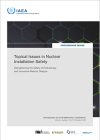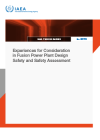The design of a nuclear power plant needs to consider specific site characteristics, operational aspects and future decommissioning plans so as to achieve the highest levels of safety. A comprehensive and thorough safety assessment is mandatory to ensure the adequate protection of workers, the public and the environment.
Design of nuclear power plants
The objective of the design is to provide for the safe and effective operation of the nuclear power plant, minimising the likelihood of accidents and ensuring that their consequences can be reliably mitigated.
The primary means to achieve this is the ‘defence in depth’ approach, consisting in the implementation of consecutive and independent levels of protection. In relation to design, the safety provisions of the ‘defence in depth’ approach include: an adequate design for the site characteristics, multiple physical barriers to the release of radioactivity, and the application of strong safety requirements and proven engineering practices to ensure adequate safety margins and a high reliability of design features that preserve the integrity of these barriers.
This is achieved mainly by the use of technology and materials of high quality, control, surveillance and protection systems, and an appropriate combination of inherent safety features and engineered safety systems. These items must also meet stringent requirements for withstanding internal and external hazards, redundancy and diversity, as appropriate. The ‘defence in depth’ approach also relies on effective management systems.
The safety of the plant needs to be demonstrated throughout all stages of its entire lifetime, in particular before the loading of the nuclear fuel and the beginning of operation. A comprehensive safety assessment, including a deterministic and probabilistic safety analyses for internal accidents and external events, needs to be carried out to ensure that all safety requirements established for the design are met and are in accordance with relevant national and international codes and standards, laws and regulations.
A Member State’s regulatory framework should also include an independent review and assessment of the design. Mechanisms such as a periodic safety review are necessary to ensure the safety of a plant through its operational life, accounting for design changes and modernisation.
Supporting Member States in design safety and safety assessment
The designs of nuclear power plants are constantly undergoing a process of improvement and modernisation.
Design safety and safety assessment frameworks are also evolving and include state-of-the-art techniques and approaches. In order to react in a timely fashion to these dynamic developments and effectively support Member States, the IAEA focuses its efforts on the following:
- Developing and revising the IAEA Safety Standards and other technical publications
- Building capacity in Member States
- Delivering technical safety reviews








